Isometrics: Static contractions, dynamic applications
Available in:
EN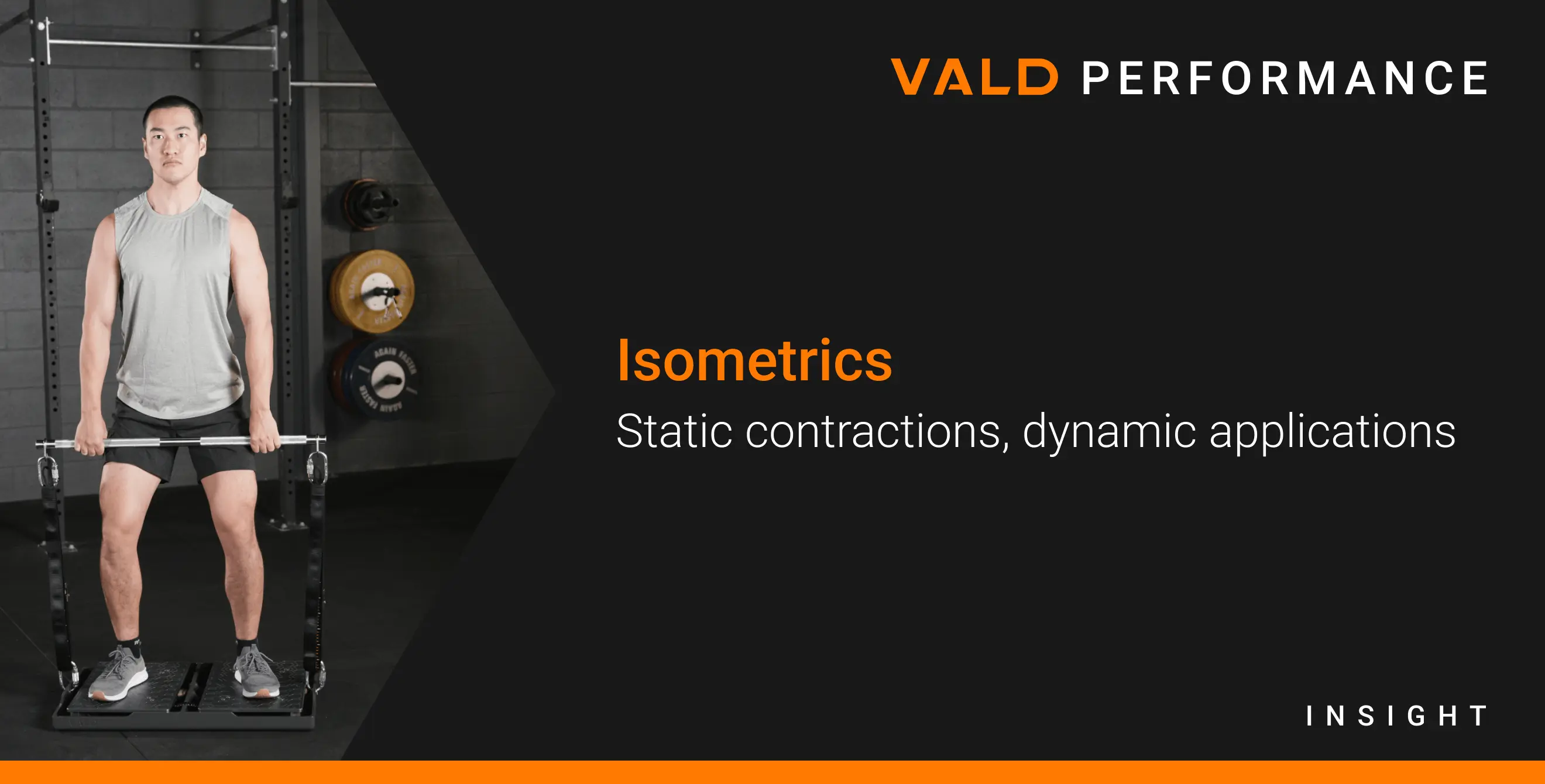
Isometric exercise – static muscle contractions without visible movement – is making a significant resurgence, with notable pioneers such as Alex Natera, Danny Lum and Ebonie Rio emphasizing their applicability in sports performance, rehabilitation and general health.
Though not a new concept, isometric training has become more refined and effective with modern technologies. Practitioners now use isometric training as an evidence-based, measurable and highly effective tool for assessing and developing strength.
For a deeper dive into isometric testing and how to apply it with precision, explore our Practitioner’s Guide to Isometrics.

What Makes Isometrics Beneficial?
Isometric training stands apart for three key reasons:
- Safety: Isometrics, specifically pushing isometric muscle actions (PIMAs), are often self-limiting relative to the athlete’s capacity. This makes excessive, potentially dangerous overload unlikely. In contrast, dynamic movements demand active stability and adequate knowledge of physical capacity. Even minor errors in execution or excessive external loads can increase injury risk.
- Simplicity: Isometric exercises have a low barrier to entry due to their controlled execution and minimal technical demands. This makes them accessible to nearly all populations.
- Effectiveness: Isometric exercises can be tailored to target specific adaptations or assessment goals. As they are constrained by the athlete’s maximal voluntary effort, muscles can be trained at high intensities in controlled positions.
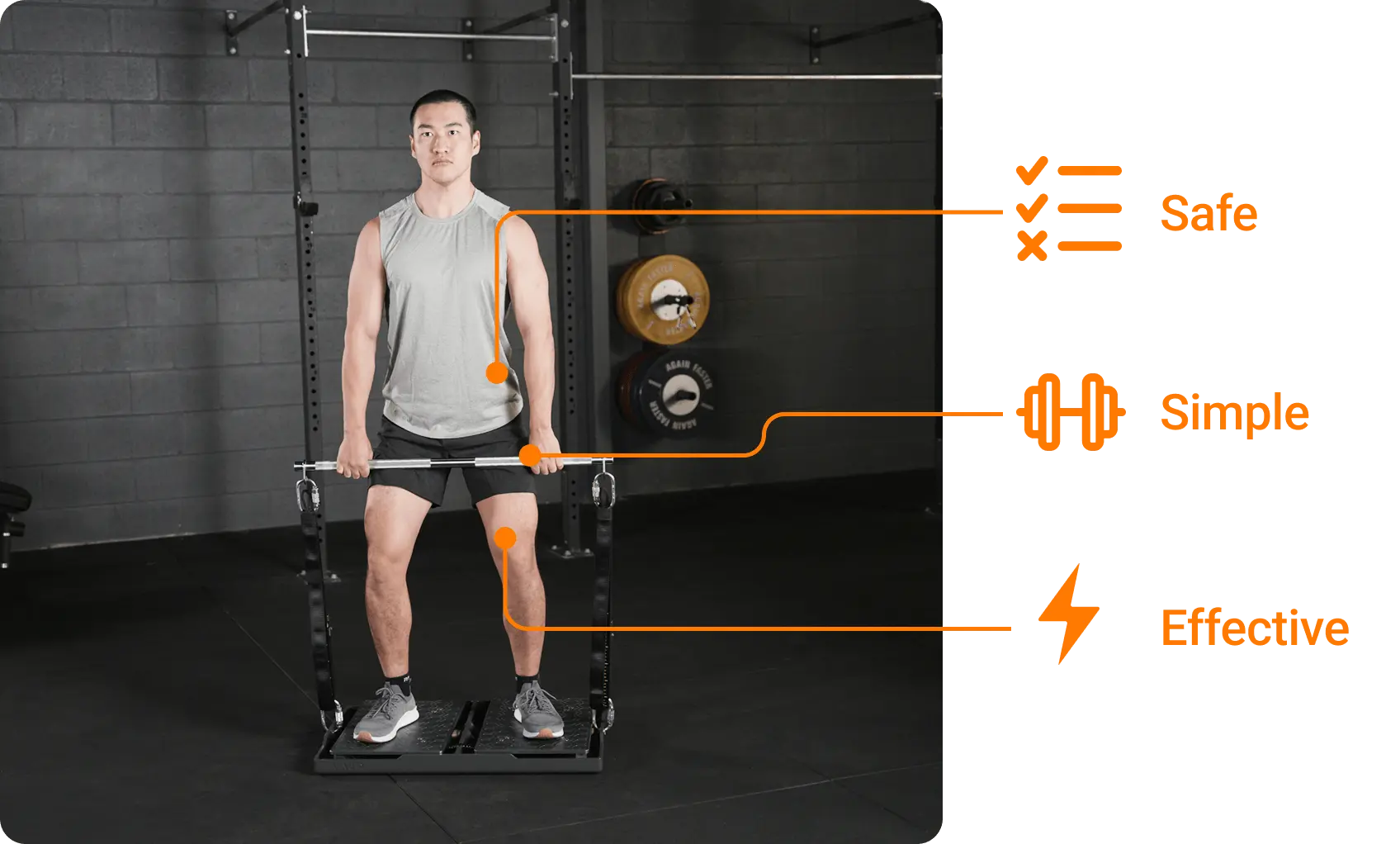
The Emergence of Isometric Assessment Technology
Clinicians historically assessed isometric strength using manual muscle testing (MMT), a subjective method that is often unreliable.
Today, HHDs, FFDs and force plates allow for precise, objective measurements of force output, asymmetry and RFD.
Today, handheld dynamometers (HHDs), fixed-frame dynamometers (FFDs) and force plates allow for precise, objective measurements of force output, asymmetry and rate of force development (RFD). Isometric testing is now a standard in musculoskeletal (MSK) health and performance settings.
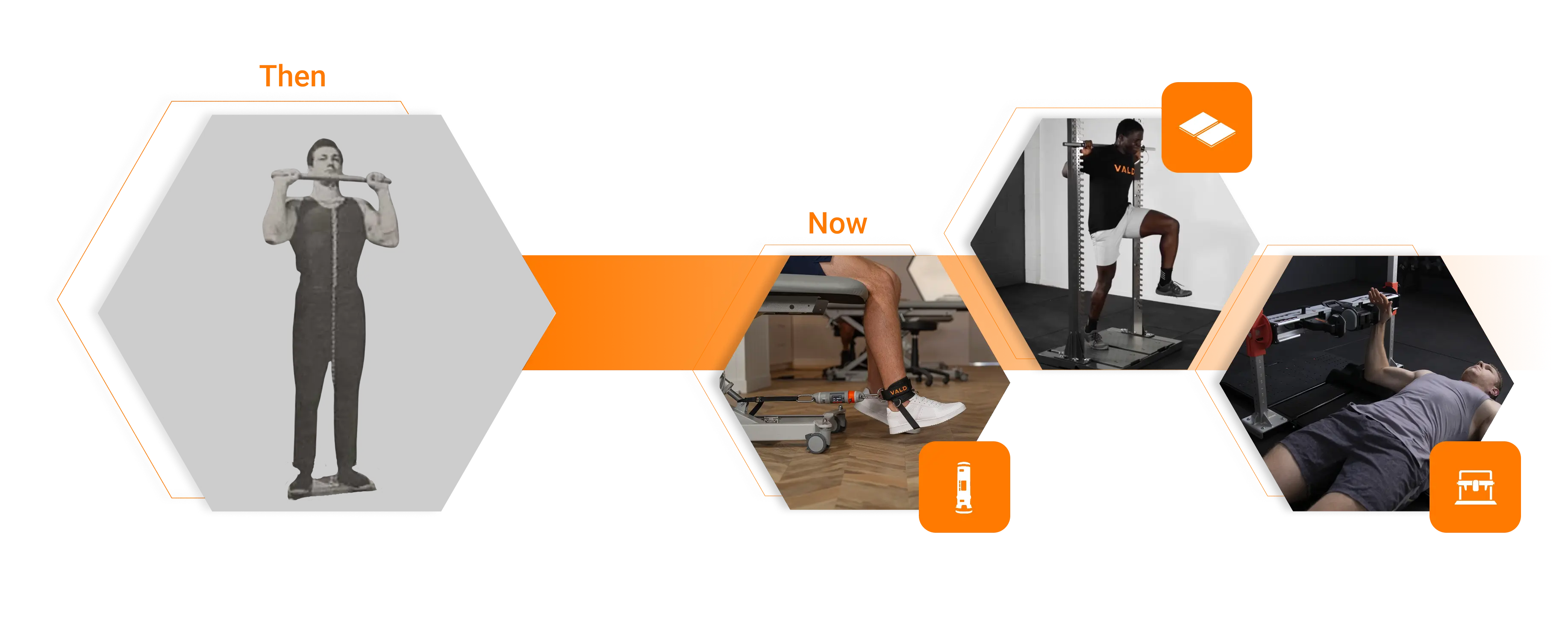
The evolution of isometric strength testing.
Are Isometrics Functional?
The term “functional” is often vague and misapplied. What is functional for one athlete may be irrelevant or even unsafe for another.
For example, “functional training” for a high-level powerlifter may take the form of maximal isometric training at specific joint angles to improve force application during a squat. For a frail elderly person, however, “functional” may involve sub-maximal pushing isometrics to avoid movements they are unprepared for (e.g., squats).
Rehabilitation and performance personnel deliver isometric exercises packaged in potent and approachable methods across a range of testing and training scenarios. Their versatility maximizes performance gains by allowing practitioners to optimize joint angles, body orientation and exercise intensity. By mimicking the demands experienced in life and sports, isometrics drive adaptations that directly support real-world performance and function.
Here are examples of how isometrics may be more functional than typical dynamic loading:
- Athlete Training: High-load isometrics – like the isometric mid-thigh pull (IMTP) or isometric squat (Iso-Squat) on ForceDecks – offer greater stability and allow athletes to optimize leverage for peak force at various joint angles. In contrast, dynamic lifts like the deadlift often overload the starting position and underload the end range. This can limit strength gains due to inconsistent leverage throughout the movement.
- Patient Rehabilitation: Single-joint isometric tests – such as Iso-30 or knee extension – allow patients to produce maximal force within pain-free ranges. This promotes strength gains even in the presence of pain. In contrast, full-range dynamic exercises may be limited by load tolerance due to joint or tissue discomfort.
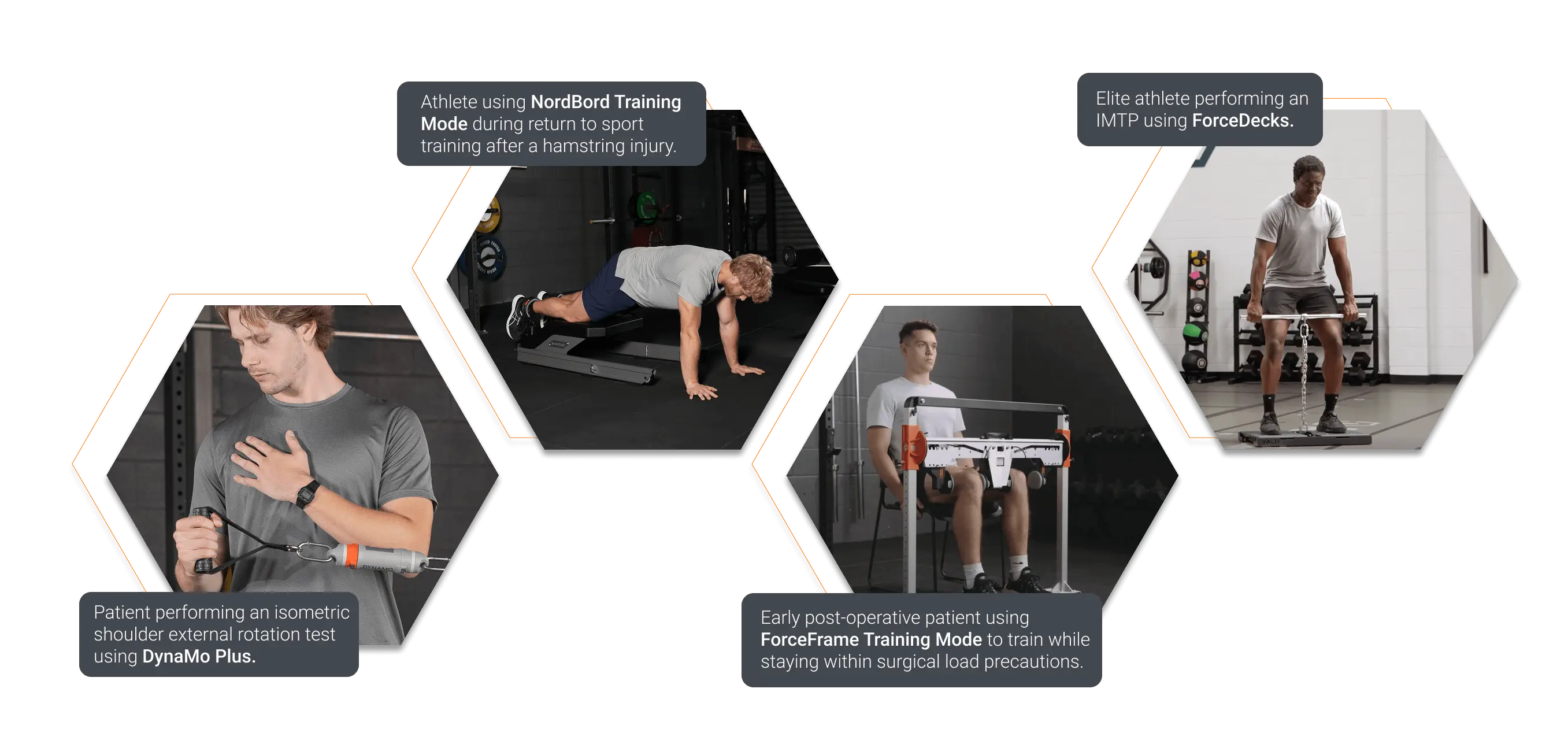
Applications and use cases of different isometric testing and training options.
The versatility and self-limiting nature of isometrics make them a go-to training method for rehabilitation and performance practitioners…
The versatility and self-limiting nature of isometrics make them a go-to training method for rehabilitation and performance practitioners alike.
Scientific Underpinnings of Isometrics
Isometric contractions generate force in fixed positions, unlike concentric or eccentric contractions.
At its core, an isometric contraction involves muscle activation without a change in joint angle. Basic muscle physiology also allows practitioners to realize a large benefit due to the high load ceiling that isometrics provide (Hill, 1922).
Force-velocity relationship of muscle, focused on the concentric portion of muscle action.
During short-duration, low-intensity isometrics, muscle fibers typically maintain their length throughout the contraction. However, in high-intensity and long-duration isometric efforts, tendon creep can occur (Kubo et al., 2001).
Creep is a behavior of soft tissues (muscle, tendon, ligament and bone) that refers to the gradual elongation of a tissue when exposed to sustained tensile load. As a signal for change, sufficient intensities of creep and other forms of tendon strain signal tendons to increase mechanical stiffness.
Improvements in tendon stiffness can enhance the muscle-tendon unit's ability to store and release elastic energy.
Improvements in tendon stiffness can enhance the muscle-tendon unit’s ability to store and release elastic energy.
Visual demonstration of changes in tendon length (strain) with constant loading over time.
Increased tendon creep (as experienced in longer isometric contractions) can lead to subtle changes in muscle-tendon unit length. The athlete’s tissues will either exhibit small amounts of lengthening or the muscle fibers will compensate by producing a slow concentric contraction to offset the elongation that occurs in the tendon.
Moreover, this subtle tissue adaptation may partially explain why isometric training can translate into improved force production, RFD and architectural changes – even without visible movement (Oranchuk et al., 2019).
Common Isometric Actions and Their Benefits
Isometric exercises have multiple applications and derivatives, with different adaptations derived from each. These exercises can be broadly categorized into two key execution types:
- Pushing isometric muscle action (PIMA) – e.g., Iso-squat
- Holding isometric muscle action (HIMA) – e.g., Isometric knee extension against a given percentage of a one-repetition max (1RM)
These two isometric execution types can be applied in various forms.
| Execution | PIMA Example | HIMA Example |
| Pushing | Knee Iso-Push | Standard Wall Sit |
| Pulling | IMTP | Isometric Dumbbell Row Hold |
| Squeezing | Bilateral Hip Adduction Squeeze | Cable Pec Fly Hold |

These same actions, when paired with testing tools, also provide objective strength data. Data provides direct knowledge of an athlete’s or patient’s true physical qualities, helping inform training and rehabilitation decisions for health and performance practitioners.
Training vs. Testing: A Unified Framework
Isometrics are valued for their simplicity and versatility across a range of settings. While rep-max tests and isokinetic dynamometry can measure force capacity, isometric testing offers a valid substitute – providing precise and efficient data without the time demands of other methods (Norris et al., 2023).
Isometrics are valued for their simplicity and applicability across a range of settings.
Their constrained nature limits variability and delivers reliable force measures. This makes them especially useful in high-performance and rehabilitation environments where objective, repeatable outputs are essential.
However, this objectivity comes with a caveat. A common limitation of any performance metric is the temptation to train for the test rather than train for function or transfer. While not highlighting a flaw in isometric testing itself, Goodhart’s Law explains how practitioners can misapply assessment results.
Goodhart’s law states, “When a measure becomes a target, it ceases to be a good measure.”
“When a measure becomes a target, it ceases to be a good measure.”
Performance tests are meant to track improvements in physical qualities such as strength, power or endurance. However, when assessment positions are regularly used as training interventions (e.g., integrating IMTPs into training), improvements in test performance may reflect a learning effect rather than actual gains in the underlying quality.
Goodhart's Law explained.
This is analogous to giving a student all the exam questions a week in advance. Their performance is likely a reflection of memory rather than understanding – defeating the purpose of the test.
Ultimately, objective data is only as useful as the practitioner’s ability to interpret and apply it within a broader context. The value of isometric assessment lies not only in what it measures but in how those measurements can inform decision-making and guide individualized programming.
For a better understanding of practical applications of isometric tests, such as the IMTP, refer to our Practitioner’s Guide to Force Plates.

Isometric Testing Considerations
When designing isometric assessments, start with the end in mind:
- What physical quality are you targeting?
- What best-practice protocols exist?
- What safety measures should you consider?
Choosing the test that best aligns with training and rehabilitation goals ensures measurement success coincides with task outcomes.
To maximize practitioner confidence in isometric testing data, consider the following best-practice options for isometric testing:
- Use validated technology
- Follow standardized protocols
- Zero devices and, if relevant, weigh athletes before each test
- Provide consistent cues
- Sustain pretension and minimize countermovements during rapid contractions
Understanding Key Metrics
Modern devices such as ForceDecks and DynaMo capture multiple characteristics relevant to performance assessment and training. Key metrics such as peak force and asymmetries help inform return-to-play decisions, injury risk assessments and strength programming.
Force time signature of a well-executed bilateral isometric test.
| Quality | Metric | Description |
| Maximum Strength | Peak force | Maximum force registered within the testing duration. |
| Explosive Strength | RFD | The rate of change in force production. |
| Time to 80% Peak Force | Time to 80% peak force | The amount of time it takes the subject to reach 80% of the peak force registered in the test. Offers a more reliable measure of explosive strength. |
| Asymmetry | Peak force asymmetry | Percent difference in maximum force output between two limbs. |
Choosing the Right Tool
Three primary isometric testing tools exist to provide precise insights for both athletes and patients. Each device has specific use cases that allow them to excel in a particular environment.
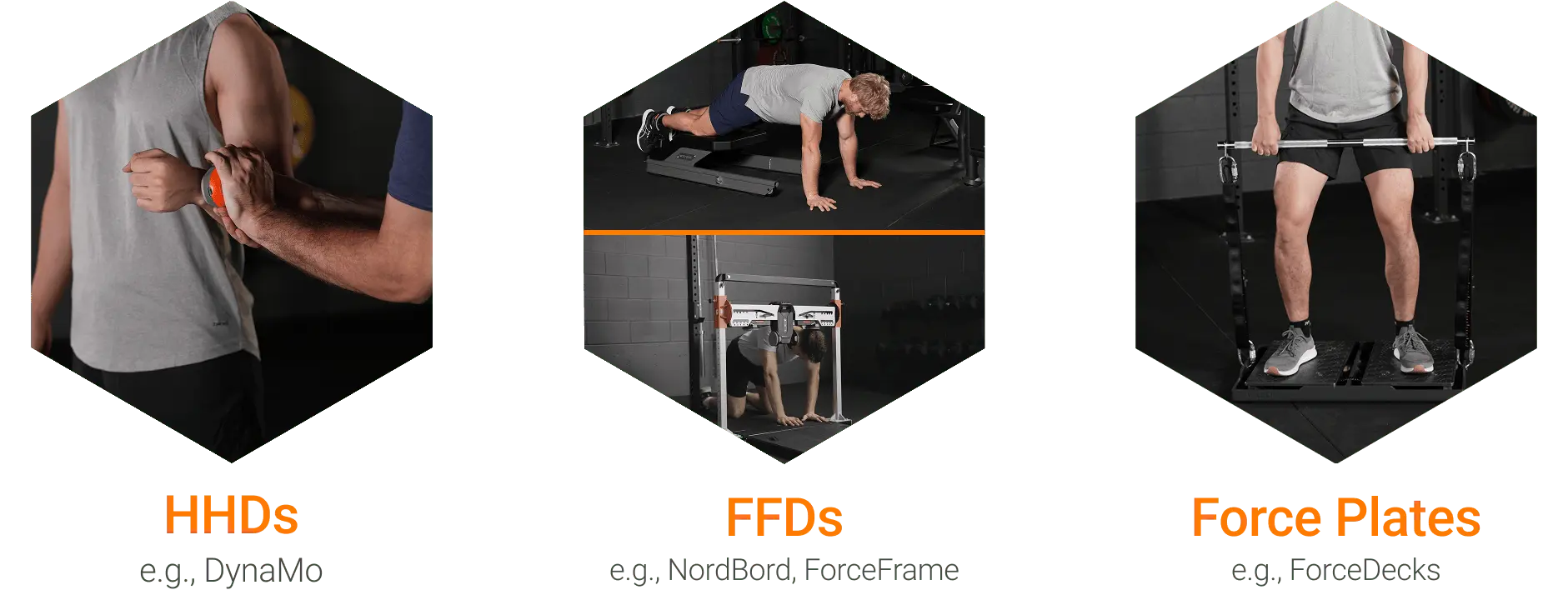
- HHDs: Portable, cost-effective and ideal for quick testing across multiple joints. The DynaMo range is most often applied in health and rehabilitation scenarios.
- FFDs: Often more reliable due to fixed positioning and consistent test conditions. ForceFrame and NordBord are commonly integrated into performance and return-to-play scenarios due to their high load capacity.
- Force Plates: Offer detailed data on lower-limb strength, balance and asymmetries. ForceDecks provides high-quality measurement solutions in multiple sizes, making them applicable throughout health and performance settings.
| System | Use Case | Common Assessments |
|---|---|---|
| HHDS | Isolated joint strength and RFD. | |
| FFDs | Isolated joint strength in bilateral and unilateral assessments. | |
| Bilateral and unilateral posterior chain strength. | ||
| Force Plates | Bilateral and unilateral compound isometric strength. |
Practical Applications of Isometric Training
Coaches and therapists implement isometric exercises as a foundational method for developing strength, promoting hypertrophy and improving joint stability. With precise and intentional use, they provide distinct advantages that enhance training outcomes across a wide range of applications.
…[isometrics] provide distinct advantages and applications that enhance training outcomes across a wide range of applications.
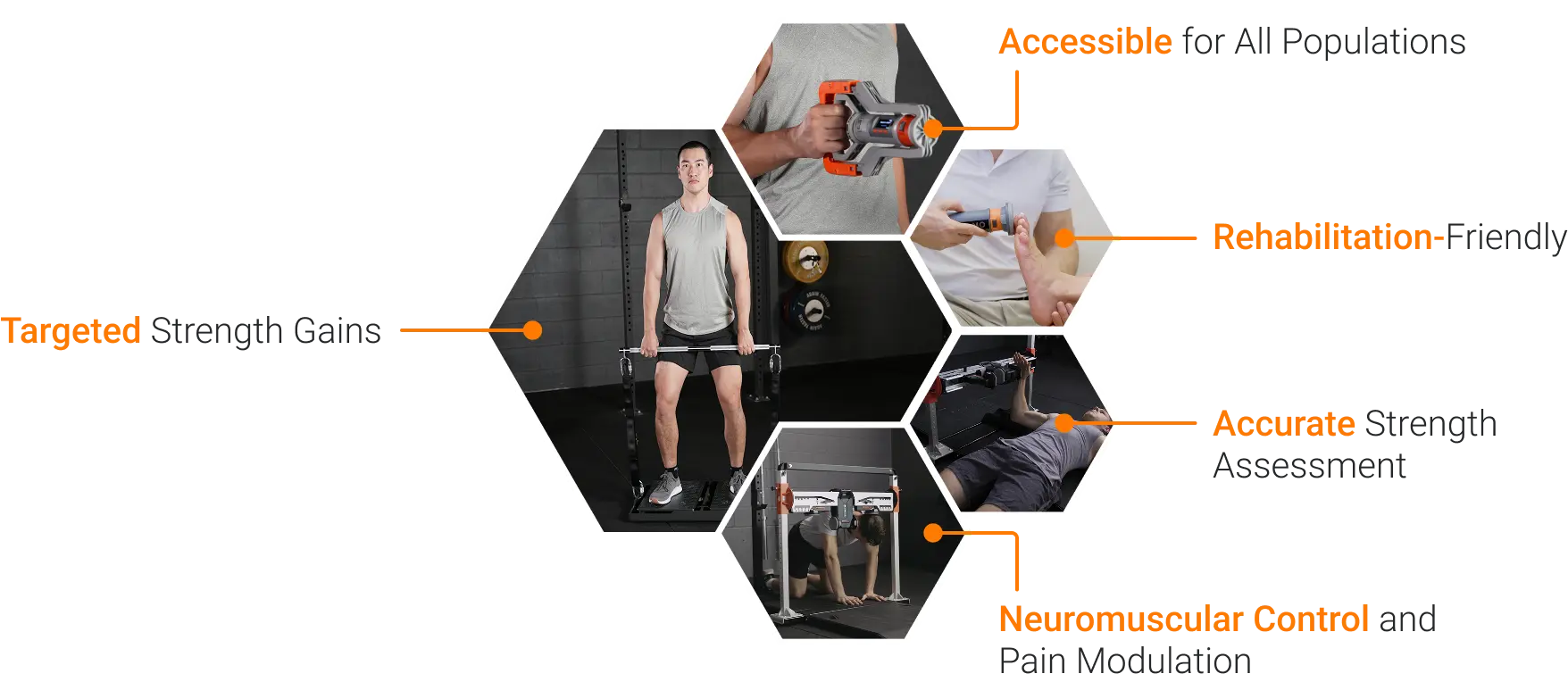
Prior to technology-enabled applications, practitioners were limited to using sets, reps, rate of perceived exertion (RPE) and time when tracking isometric training. These offered little insight into an athlete’s output or performance within and across sets.
Now, tools such as ForceFrame and NordBord allow for precise quantification of isometric training performance through their specialized “Training Mode” feature.
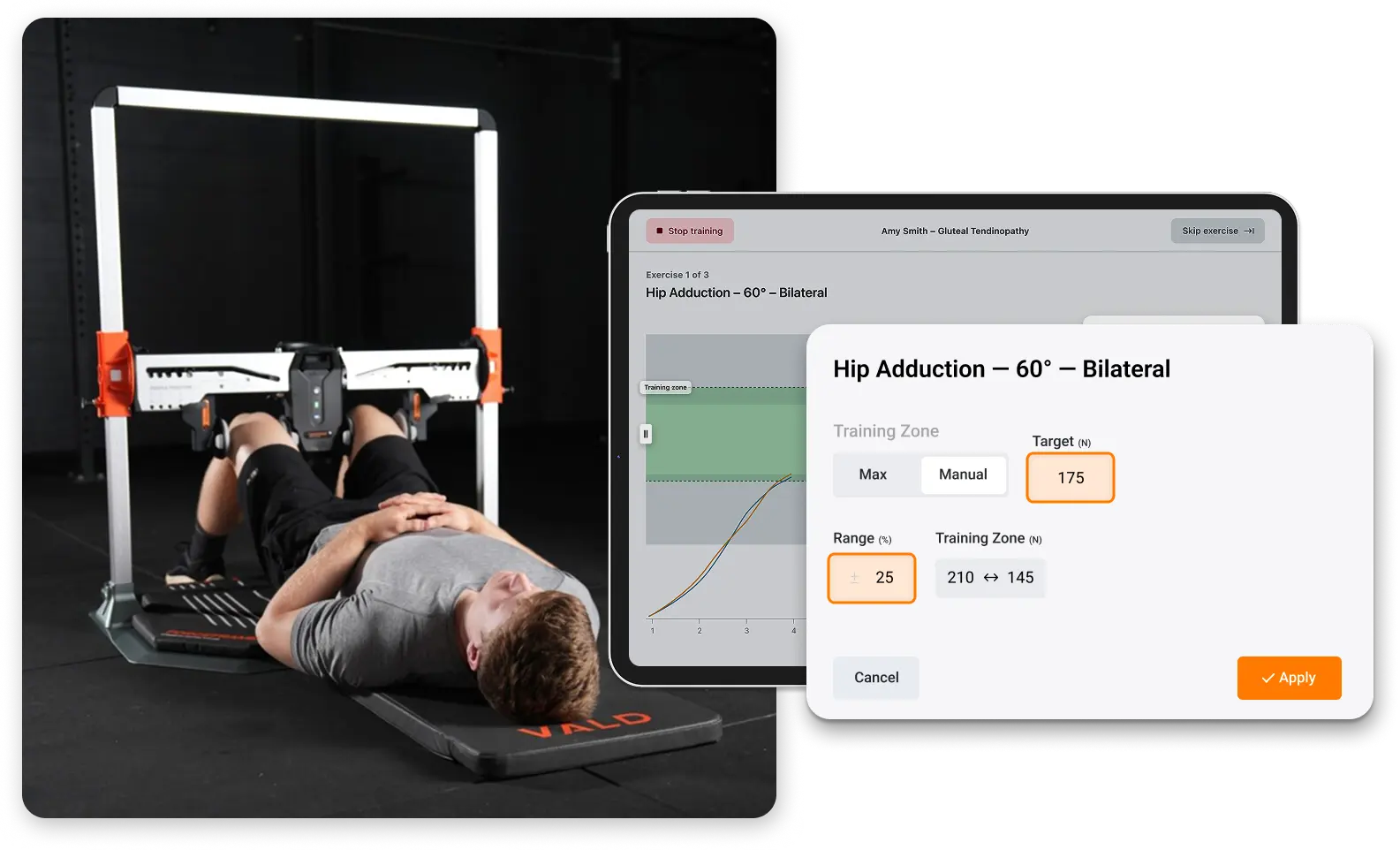
An athlete using ForceFrame’s Training Mode to adjust Training Zone within their set to optimize performance and recovery.
...tools such as ForceFrame and NordBord [Training Mode] allow for precise quantification of isometric training performance.
Practitioners can use Training Mode to precisely and objectively dose their training load to match the intensity and adaptation they are looking for. By providing real-time biofeedback of isometric performance and immediate result scoring of isometric performance, Training Mode takes isometric training to new heights.
Isometric Training Tips for Optimal Results
To get the most from isometric training, consider the following best practices:
- Align with Sport Demands: Choose isometric exercises that replicate the joint angles and contraction types specific to your sport or activity (e.g., pushing for linemen, holding for climbers).
- Account for Fatigue Differences: HIMAs tend to produce more localized fatigue than PIMAs, therefore adjust repetition durations accordingly. HIMAs may require shorter hold times even at the same intensity.
- Monitor Recovery: Isometric work typically produces less global fatigue, allowing for quicker recovery. This makes it a powerful tool for in-season training and high-frequency programming.
- Use Real-Time Feedback: Biofeedback tools such as VALD’s ForceFrame and DynaMo provide athletes with instant data on force output, helping to maximize intent and engagement. Tracking metrics like RFD and asymmetry over time also allows for smarter, data-driven progression.
Isometric training is no longer just a niche technique – it is a science-backed, tech-enabled strategy that offers unmatched efficiency, safety and effectiveness. Whether you are a physical therapist, strength coach or healthcare provider, isometrics deserve a permanent place in your toolkit.
To see how VALD technology can support your isometric testing and training performance, get in touch with our team.
References
- Hill, A. V. (1922). The mechanism of muscular contraction. Physiological Reviews, 2(2), 310–341. https://doi.org/10.1152/physrev.1922.2.2.310
- Kubo, K., Kanehisa, H., & Fukunaga, T. (2001). Effects of different duration isometric contractions on tendon elasticity in human quadriceps muscles. The Journal of Physiology, 536(2), 649–655. https://doi.org/10.1111/j.1469-7793.2001.0649c.xd
- Oranchuk, D. J., Storey, A. G., Nelson, A. R., & Cronin, J. B. (2019). Isometric training and long-term adaptations: Effects of muscle length, intensity, and intent: A systematic review. Scandinavian Journal of Medicine & Science in Sports, 29(4), 484–503. https://doi.org/10.1111/sms.13375
- Norris, R., Morrison, S., Price, A., Pulford, S., Meira, E., O’Neill, S., Williams, H., Maddox, T. W., Carter, P., & Oldershaw, R. A. (2024). Inline dynamometry provides reliable measurements of quadriceps strength in healthy and ACL-reconstructed individuals and is a valid substitute for isometric electromechanical dynamometry following ACL reconstruction. Knee, 46, 136–147. https://doi.org/10.1016/j.knee.2023.12.006
